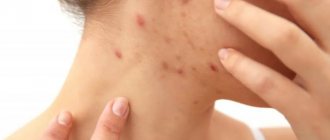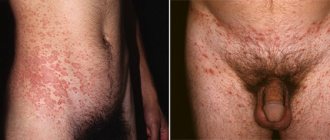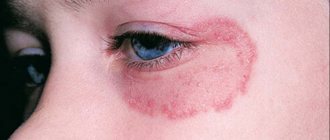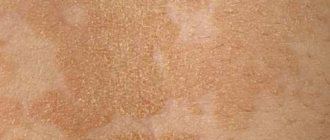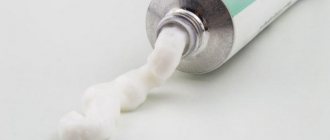Ringworm is a general name for a group of skin diseases that manifest as characteristic rashes that can be localized in different parts of the body.
Infections differ in pathogen, clinical manifestations, severity and treatment tactics. One of the fairly common types of lichen is Zhiber's pink lichen.
Zhiber's pityriasis rosea is an acute inflammatory dermatosis of unknown etiology that develops against a background of weakened immunity, for example, after an acute respiratory viral infection or influenza. Most often, the disease is diagnosed in adolescents and young adults, while it is rare in children and the elderly.
Doctors do not have a clear opinion about the causes of pityriasis rosea, but most dermatologists are inclined to believe that the causative agent of the infection is herpes virus types 6 and 7. The herpes virus remains in a latent state in the human body for a long time, but when the protective forces are weakened, it begins to actively develop and affects the upper layers of the skin with the formation of symptoms of pityriasis rosea.
What does pityriasis rosea look like?
The main symptom of lichen Zhiber is the appearance of a characteristic pink rash. First, a bright, slightly convex plaque with a diameter of 2 to 5 cm is formed on the body, the center of which may peel off slightly and differ in color from the edges. This is the so-called “maternal plaque”, next to which, after 5-10 days, small pink spots (up to 2 cm in diameter) appear along the skin tension lines (Langer’s lines).
“Daughter” rashes do not appear simultaneously, but throughout the entire illness. The rash is bright pink, peeling in the center. But after 4-5 weeks it begins to lose pigmentation, the plaques peel off without the formation of scar tissue or scars.
A number of patients may have atypical pityriasis rosea, in which the maternal plaque is absent and the body is covered with small pink spots.
Dermatologists also distinguish the following types of atypical Zhiber disease:
- urticarial - instead of pink plaques, blisters appear on the skin;
- vesicular - rashes consist of small blisters filled with clear or cloudy liquid;
- papular - cavity-free formations appear protruding above the surface of the skin.
The rash is most often localized on the torso, less often on the neck, face and limbs.
Fukortsin
Coloring antiseptic. A combination of fuchsin, boric acid, phenol, acetone, resorcinol and ethanol. Indications for the use of fucorcin are fungal and pustular skin diseases, abrasions, cracks, etc. Apply to the edges of wounds. Has less drying effect than brilliant green and iodine. It is used much less frequently in wound treatment. It is undesirable to use in children due to the boric acid and phenol contained in it, which have a large number of side effects. When applied to the skin, boric acid easily penetrates the blood (especially in children) and enters the internal organs and tissues, accumulating there. Therefore, long-term use can cause intoxication. This property forced us to sharply limit the use of boric acid, especially in childhood. Phenol also has the ability to easily penetrate the skin and lead to intoxication of internal organs.
How is Zhiber's pityriasis rosea transmitted?
Zhiber's pityriasis rosea is not contagious - it is impossible to catch it from a sick person, even with close household contact: using shared dishes or towels. Therefore, patients do not need to quarantine or limit social contacts; they can continue to lead their normal lives during therapy.
Most dermatologists are inclined to believe that Zhiber's pityriasis rosea is caused by the herpes virus, which is present in the human body in a latent form.
Activation of the pathogen occurs against the background of decreased immunity, which can be caused by:
- hypothermia;
- recent injuries, surgeries and infections;
- overwork and stress;
- long-term exposure to adverse factors: for example, toxins at work;
- bad ecology;
- alcohol abuse;
- chronic diseases: diabetes, heart failure;
- hormonal fluctuations: for example, pregnancy in women;
- sudden climate change;
- smoking;
- unbalanced diet.
Most often, the virus is activated in the spring and autumn, during the season of influenza and ARVI epidemics. Vitamin deficiency, uncontrolled use of medications, and a course of antibiotics can contribute to the development of Zhiber's disease.
Iodine/povidone-iodine
Used in an alcohol solution (the so-called “tincture of iodine”) or in Lugol’s solution. Only the edges of the wound are treated with iodine so as not to cause soft tissue burns. The great advantage of iodine is its wide spectrum of antimicrobial activity: it kills all major pathogens and, with prolonged exposure, even spores - the most resistant forms of microorganisms. The use of large amounts of iodine is contraindicated in cases of hypersensitivity to it, hyperfunction of the thyroid gland, thyroid formations, dermatitis, and kidney diseases. Application to mucous membranes is not advisable, especially in children.
Do pityriasis rosea need to be treated?
Many patients mistakenly consider Zhiber's disease to be a harmless dermatosis that does not require therapy or contact a dermatologist. Despite the fact that the disease is prone to self-healing, improper treatment or its absence can lead to a long course of infection (up to six months or more) and various complications.
If a rash is detected on the body, it is recommended to make an appointment with a dermatologist or dermatovenerologist as soon as possible.
This is necessary to make an accurate diagnosis: pityriasis rosea can easily be confused with such dangerous diseases as:
- seborrheic eczema;
- psoriasis;
- parapsoriasis;
- mycosis of smooth skin.
For diagnosis, in addition to a general examination, a dermatologist prescribes a number of tests:
- general blood and urine analysis;
- skin scraping;
- serological study.
Based on the results, appropriate treatment is prescribed. The dermatologist develops a treatment regimen taking into account the individual characteristics of the patient’s body, the course of the disease, and the symptoms present. This allows you to select the most effective drugs that bring significant relief from the first use.
Why does pityriasis rosea recur?
Viral infections tend to recur. Lack of treatment for pityriasis rosea leads to the fact that the pathogen is not eliminated, and after some time (usually 4-6 weeks) it goes back into a latent form until a new weakening of the immune system. Because of this, many patients experience symptoms of Gibert's disease after each seasonal cold or severe stress.
The first manifestations of the disease are:
- formation of a large pink “mother plaque”
- mild itching of the skin;
- a feeling of tightness of the skin in the area of the rash.
Subsequently, “daughter” spots appear that do not go away within several months unless you consult a dermatologist. In some cases, patients may experience other signs of a viral infection: a slight increase in body temperature, weakness, and decreased performance.
To recover, it is necessary not only to eliminate the symptoms of pityriasis rosea, but to get rid of the cause that caused the disease, and also to destroy the pathogen. This requires complex therapy under the supervision of an experienced dermatologist.
Is it possible to cure pityriasis rosea permanently?
Many patients, faced with a recurrent disease, are interested in whether it is possible to get rid of pityriasis rosea forever? It is possible if you consult a dermatologist. The doctor will not only select highly effective medications to eliminate rashes and itching, but will also develop preventive recommendations to prevent relapse.
Typically, the treatment regimen for pityriasis rosea includes the use of the following medications:
- local ointments with corticosteroids: act simultaneously on several levels - relieve skin tightness, promote rapid healing of the rash;
- antihistamines – eliminate itching;
- immunomodulators - activate natural defense mechanisms to combat pathogens.
Additionally, a dermatologist may prescribe treatment of rashes with antiseptic solutions to prevent secondary infection by bacteria, as well as emollient ointments for severe peeling.
Following medical recommendations will allow you to quickly recover and forget about Zhiber’s disease forever.
How to cure pityriasis rosea during pregnancy?
Hormonal changes that occur in the body of a pregnant woman often provoke the development of various diseases, including pityriasis rosea. The disease is not dangerous for the fetus, but requires close attention, since it indicates a weakened immune system of the expectant mother and can cause significant discomfort.
The main rule that a pregnant woman should follow when treating pityriasis rosea is not to use any medications or ointments without first consulting a doctor. “Folk methods” can be no less dangerous for the fetus. Any impact on the body is allowed only after agreement with a dermatologist. The complex of drugs is selected by a specialist and may include ointments, vitamin preparations, and antiseptics.
It is also important for patients to follow the following recommendations:
- refuse to visit the bathhouse, sauna, swimming pool. Instead of a bath, you should take a shower without using a hard washcloth or rubbing with a towel;
- choose spacious linen made from natural fabrics. Synthetic materials interfere with the natural breathing of the skin, increase sweating, which leads to worsening the symptoms of pityriasis rosea and the appearance of new rashes;
- exclude foods that cause allergies from the diet: eggs, red berries and fruits, chocolate. It is also recommended to reduce the amount of fried, flour, smoked foods and replace them with boiled vegetables;
- Do not use cosmetics on damaged areas of the skin.
By following the doctor’s recommendations, the girl will quickly restore her health without negative effects during pregnancy.
Is it possible to smear with brilliant green for lichen?
It is important to visit a doctor who will determine the nature of the lichen and whether there is a need to use the remedy.
Zelenka does not affect the deep layers of the dermis and only affects bacteria located on its surface. The use of brilliant green is not accompanied by interstitial pressure and irritation, which is characteristic of iodine. Therefore, if you cauterize a person’s lichen with this antiseptic, it will not harm the health of the skin. The main thing is not to smear the affected areas of the skin often, so as not to dry them out. The product does not have an antifungal or antiviral effect, so its use in the fight against lichen is not always effective. Before applying the product to your skin, you should consult your doctor.
What does pityriasis rosea look like when it goes away?
With proper treatment, pityriasis rosea goes away without the formation of scars. After exfoliation of the plaques, clean skin remains in their place, sometimes a lighter shade, but over time this defect disappears. However, in patients with atypical forms of Gibert's disease, the formation of difficult-to-heal ulcers is possible.
Self-medication and lack of qualified medical care increases the risk of complications:
- secondary infection of the rash with bacterial flora;
- the appearance of suppuration and ulcers;
- the formation of areas of hyperpigmentation after recovery.
To prevent such a development of the disease, at the first symptoms of pityriasis rosea, it is recommended to make an appointment with a dermatologist.
After recovery, the doctor will develop recommendations to prevent relapses.
They usually include a number of activities to strengthen the immune system:
- regular intake of vitamin complexes in the autumn-spring period;
- proper rest, especially during times of increased intellectual, physical or psycho-emotional stress (exams, important projects, other stress);
- rejection of bad habits;
- moderate physical activity;
- maintaining a balanced diet, with limited consumption of allergenic foods, as well as smoked, fatty, flour foods.
Following these tips allows you to maintain immunity, which suppresses the herpes virus and prevents the recurrence of pityriasis rosea.
Why can't you scratch pityriasis rosea?
Zhiber's pityriasis rosea can occur without symptoms, including without skin irritation. But some patients suffer from itching in the area of the rash. As with other dermatoses, you should not scratch the site of infection.
Violation of this rule leads to:
- damage to the top layer of skin and the appearance of scratches;
- the risk of introducing bacterial flora into the plaque, which will cause inflammation and suppuration of the tissue;
- increase in the area of rashes.
To cope with itching and skin irritation, seek help from a dermatologist or dermatovenerologist. The doctor will select corticosteroid ointments to relieve inflammation and antihistamines to relieve itching and burning.
Chlorhexidine bigluconate
Belongs to the group of halogens. Typically used in concentrations of 0.5–4.0%. At lower concentrations, the bactericidal activity of chlorhexidine decreases, therefore, as an antiseptic in this case, it is used only in an alcohol solution. Chlorhexidine has bacteriostatic, fungicidal, antiviral properties. However, 1% chlorhexidine against fungi and mycobacteria tuberculosis has a weaker effect compared to povidone-iodine. The drug can be used for the initial treatment of injured skin areas, as well as to accelerate the healing of purulent wounds and for the treatment of damaged mucous membranes. In most cases it is well tolerated. There are no age restrictions for use - a good antiseptic option for children. It is not recommended to use together with iodine preparations (often skin irritation).
Can pityriasis rosea be smeared with iodine or brilliant green?
Iodine and brilliant green are one of the most accessible and widely known antiseptic drugs for treating scratches and other superficial wounds. Many patients who are faced with pityriasis rosea “out of habit” use these remedies to treat the rash. But this approach does not give results.
The virus that causes pityriasis rosea is concentrated in the deep layers of the skin - iodine and brilliant green will not be able to eliminate the cause of the infection. In addition, both products dry out the skin greatly and can lead to additional chemical burns. As a result, the patient will only worsen the symptoms and delay recovery. Iodine and brilliant green should not be used to treat Gibert's disease.
Hydrogen peroxide
Only a 3% solution is used to treat wounds (a higher concentration can cause a chemical burn). It is also used as a hemostatic agent. Hydrogen peroxide is an excellent remedy for primary wound treatment (washing), as it has great cleaning ability - dirt particles and damaged cells are mechanically removed with the resulting foam. You can treat wounds both on the surface of the skin and on the mucous membranes. Hydrogen peroxide is generally not used on healing wounds, as it prolongs the period of complete healing. It is also not used for deep wounds and is not injected into body cavities. When stored in light, it loses its active properties. Open packaging is stored for about a month, closed - 2 years.
Is it possible to treat pityriasis rosea with celandine?
Another popular “folk recipe” for treating lichen is using celandine. However, the juice of this plant (as well as a decoction from it) is also not able to penetrate into the deep layers of the skin, that is, it will not be able to cope with the causative agent of the disease.
Also, celandine does not help speed up the healing of the skin, but can lead to additional damage and inflammation. It should be remembered that the juice of this plant is poisonous, can cause burns, worsen general health and cause a number of side effects. Therefore, the use of celandine not only will not alleviate the patient’s condition, but may also aggravate it, increasing the risk of complications.
Treatment of pityriasis
When a patient is diagnosed with Gibert's disease, the dermatologist develops an individual treatment regimen to avoid dangerous complications. There is an opinion that pityriasis rosea will go away on its own in a few weeks. As a result, complications arise, and the patient comes to the dermatologist with an advanced form of the disease.
Drug treatment includes the following medications:
- antihistamines that relieve the patient from itching, swelling and redness on the body
- corticosteroid, desensitizing and antipruritic ointments. Medicinal compositions containing betamethasone, hydrocortisone, etc. are applied to the affected skin and lightly rubbed in. The medications eliminate rashes, get rid of peeling, and effectively restore the skin.
- drying agents containing zinc to accelerate skin healing
- Broad-spectrum antibiotics are indicated in cases where a bacterial infection is associated with pityriasis rosea. It is unacceptable to start taking antibacterial drugs on your own, since they are selected individually, taking into account laboratory tests.
- antifungal medications: drugs containing clotrimazole and other active substances are prescribed topically in the form of gels and ointments
- antiviral drugs containing acyclovir and other active components. Dermatological tests have confirmed that if antiviral drugs are prescribed in combination with antibiotics from the first days, the patient quickly recovers.
- neutral water-shaken preparations Dermatologists prescribe pharmacy talkers containing zinc oxide, menthol and anesthesin to patients with pityriasis rosea. These products relieve itching and pain in damaged areas and speed up recovery.
- iodine is an aggressive, but extremely effective remedy. Injured skin is treated with iodine in the morning and evening. Initially, the skin begins to peel off more actively, but then there are no extra scales left on it. Not all experts recommend that their patients cauterize damaged areas with iodine, since this drug can be harmful if used incorrectly.
Recommendations for patients
During the treatment period, the patient is recommended to adhere to the following recommendations:
- Follow a hypoallergenic diet: avoid nuts, citrus fruits, chocolates, honey, etc. Products containing artificial colors should be excluded from the menu. It is worth limiting the consumption of fried foods, carbonated drinks, fast food, strong alcohol and coffee.
- Limit water treatments within reasonable limits and give preference to the shower.
- Refuse to use aggressive hygiene and cosmetic products for the body. Gels and other detergents should not dry out the skin.
- Give preference to underwear made from natural fabrics.
- Moderate sunbathing - ultraviolet light helps the skin recover faster.
- Follow the recommendations of a dermatologist, apply to the skin only products recommended by a specialist.
- Folk remedies can be used only after consultation with your doctor.
Is it possible to apply zinc ointment to pityriasis rosea?
Zinc ointment is a popular antiseptic with a softening effect. This remedy is indeed prescribed for the treatment of certain skin diseases, in particular eczema. But it is indicated for use in the treatment of rashes that produce exudate (that is, weeping ulcers), since it has a pronounced drying effect.
In the case of pityriasis rosea, there is no exudate; moreover, the plaque often flakes off and causes a feeling of tightness. The use of zinc ointment can intensify this unpleasant symptom. To improve the condition of the skin, you can use local preparations with a pronounced moisturizing effect. They often contain natural vegetable oils, as well as antiseptic components. But a dermatologist should select medications.
Brilliant green solution
Everyone's favorite "green". Available in the form of alcohol solutions and pencils. It has a moderate antiseptic effect and is effective against gram-positive bacteria. Only the edges of the wounds are treated with the solution, without going into damaged tissue. Has a drying effect. It is used until the period when fresh granulation tissue begins to appear in the wound, since long-term use prevents adequate healing of the wound edges. Can be used as a children's antiseptic.
Can pityriasis rosea be treated with salicylic acid?
Salicylic acid, like salicylic alcohol, is another popular antiseptic. It disinfects the skin and fights a wide range of bacteria, viruses and fungi. But in the case of pink lichen, its use is ineffective: the virus is located in the deep layers of the skin.
Antiseptic agents in the treatment of Gibert's disease are used only to prevent the risk of secondary infection of the rash with bacterial flora, and not to combat the pathogen itself. But it is not recommended to use salicylic acid and alcohol for this purpose either: both substances dry and irritate the skin and increase peeling. The effect of using the product will be the opposite: the rash will take longer to heal, and after healing, marks with disturbed pigmentation may remain.
Classification of antiseptics
Halides (halogens and halogen-containing compounds) Chlorine or iodine compounds (antiformin, iodoform, iodinol, Lugol's solution, chloramine B, chlorhexidine).
The bactericidal effect is based on the fact that upon contact with organic substrates, these products release active halogens - chlorine and iodine, which destroy the proteins of microorganisms. Due to their high bactericidal activity, they are widely used both in medical institutions and at home. Oxidizing agents (hydrogen peroxide, potassium permanganate, hydroperite). In contact with tissues, they release active oxygen, which creates unfavorable conditions for the development of anaerobic and putrefactive microbes. They are used to a limited extent due to their moderate bactericidal activity and short shelf life. Acids (salicylic, boric). A shift in pH to the acidic side leads to denaturation of the protoplasmic protein of the bacterial cell. Salicylic acid has a weak antiseptic effect, and boric acid has a large number of side effects associated with toxicity. Currently, antiseptics for treating skin are practically not used as antiseptics. Alkalies (ammonia, sodium tetraborate). Currently, drugs are practically not used as antiseptics due to their low antiseptic activity. Aldehydes (formalin, lysoform). Penetrating inside the microbial cell, they come into contact with the amino groups of proteins, which leads to cell death. The same effect explains the strong irritant effect on human mucous membranes and skin. Currently, they are used more for disinfecting surfaces in medical institutions. Alcohols (ethyl). They dehydrate tissues and irreversibly coagulate the proteins of microorganisms. They are used quite widely and have a pronounced antiseptic effect. In 2006, the WHO declared alcohol-based hand sanitizers to be the gold standard for hand sanitizers. Cationic antiseptics (benzyldimethyl-myristoylamino-propylammonium). The active substance acts on the membranes of microorganisms, leading to their death. It has a very wide spectrum of antimicrobial action, stimulates the immune system, and accelerates the healing process of wounds. Widely used in surgery, obstetrics, gynecology, traumatology, burn therapy, otorhinolaryngology and other fields of medicine. Salts of heavy metals (preparations of mercury, silver, copper, zinc, lead). The antimicrobial effect is associated with blocking the sulfhydryl groups of microbial enzymes. Use is limited due to toxicity. Dyes (methylene blue, brilliant green, fucorcin). They are active against gram-positive bacteria and cocci. Methylene blue has a very weak antiseptic effect and is practically not used. Herbal antibacterial drugs (urzaline, calendula tincture, imanin and others). Weak antiseptic properties. Rarely used. All these substances have different degrees of activity, antimicrobial spectrum and toxicity. To understand how to choose the right antiseptic, you need to be guided by all these characteristics in accordance with the intended purpose: primary wound treatment, treatment of festering wounds, or treatment of damaged mucous membranes or intact skin/mucous membranes. When choosing which antiseptic to treat a particular wound, you must also follow the instructions in order to avoid side effects, as well as determine the dosage required in a particular case. Let's take a closer look at the most popular antiseptics.
